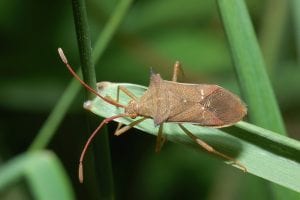
Did you know that some insects release an odor as a defense mechanism to protect themselves? Although their official name is Pentatomoidea, this is how stink bugs got their common name. Stink bugs are common in New Jersey and can be a major problem for homeowners if they aren’t kept under control. Here is what you should know about stink bugs, including what attracts stink bugs and what keeps stink bugs away.
What Is a Stink Bug?
Stink bugs are shield-shaped insects that can fly as adults and most commonly feed on plants. They can be serious pests in backyard gardens and agricultural fields that contain crops. However, some rarer species of stink bugs actually feed on other insects, which can make them beneficial to farmers. Stink bugs tend to seek warmth when the weather turns cool and can find their way into homes in the late summer and fall.
What Does a Stink Bug Look Like?
Most stink bugs are brown or green in color as adults or perhaps black, red, or yellow before they reach adulthood. These bugs are often about 1.5 to 2 centimeters long, and they have six legs and antennae. They do not bite, but they can use their beaks to pierce skin in the same way that they would the skin of a fruit. If accidently disturbed or crushed, they can release a terrible odor that is one you’ll never forget.
Where Did Stink Bugs Come From?
Some common stink bugs, such as the brown marmorated stink bugs, originated from Asia and arrived in the U.S. as an invasive species. One particular type of stink bug is known to have arrived in Pennsylvania in 1996. These bugs typically emerge from being dormant in the winter in May and early June. Then, they mate and lay eggs between June and September. You’ll begin seeing more adult stink bugs between late-August and early-October.
What Attracts Stink Bugs
Stink bugs love fruits and crops, which often makes them agricultural pests. These insects particularly enjoy feeding on plants and crops like apples, pears, grapes, pecans, citrus, cucumber, tomatoes, sunflowers, dogwood, and maple. If a stink bug releases its odor on a crop, that crop is ruined and should not be consumed. In the summer months, you’ll often find stink bugs gathered in large groups on the sides of buildings. Therefore, they can easily come indoors through open spaces and create noxious odors in your home.
What Keeps Stink Bugs Away
There are certain precautions that homeowners can take to prevent an infestation of stink bugs, such as sealing cracks and openings in the home and inspecting the home on a regular basis. The most important areas to inspect are the crawl space and attic vents. It’s also a good idea to repair broken screens and seal gaps under doors to prevent stink bugs from coming indoors. Use a silicone or silicone-latex caulk that is high-quality to make repairs and seal openings.
If you already have stink bugs in your home, you may be able to use a vacuum cleaner to remove live or dead bugs from your rooms. However, make sure to throw away the vacuum bag in an outdoor trash bag right away before the bugs’ odor spreads throughout your home. But since stink bugs pose risks to gardens, crops, and are very much a nuisance in homes, it is a smart idea to contact your local New Jersey pest control specialists as soon as you suspect a stink bug problem. Precise Pest Control has been keeping Northern New Jersey pest-free for over 25 years, and we’re equipped and ready to keep stink bugs away from your home and out of your life.
Trust us, this isn’t a smell that you want to deal with yourself and have spread all throughout your home. It’s a smell that will stick to nearly any surface and can last for six months or longer! Don’t hesitate to call us at (866) 971-2847 or contact us online anytime you need help with New Jersey stink bug control.





